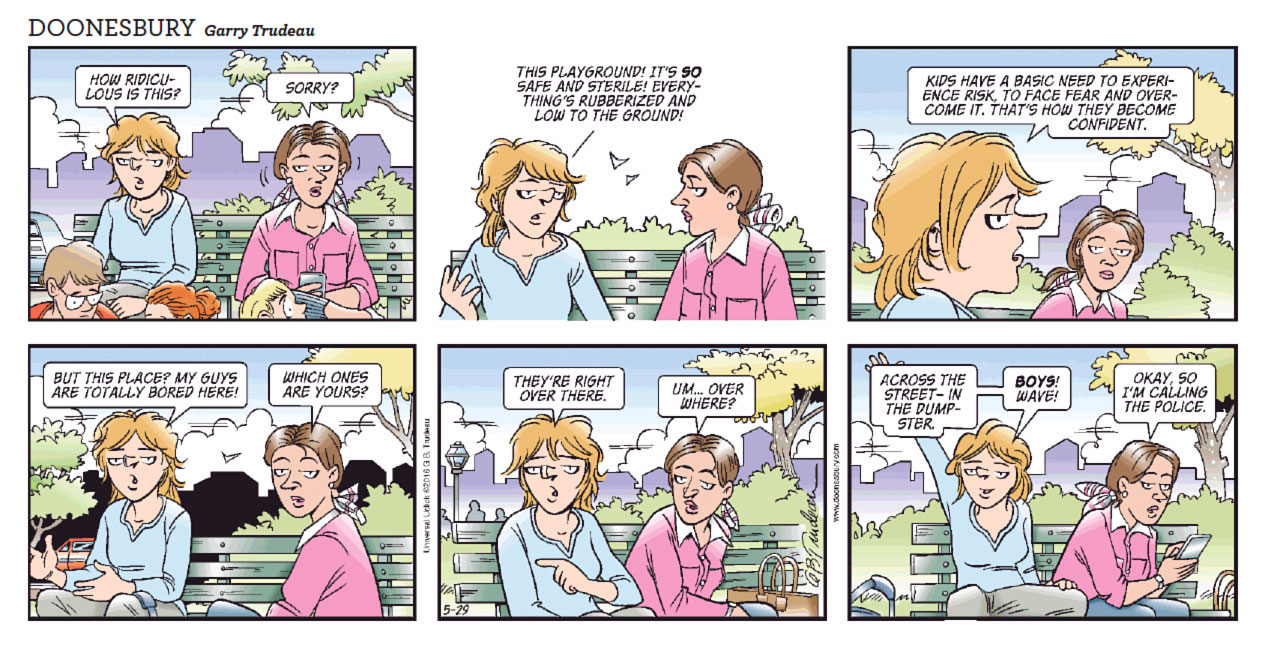Playgrounds in the Press
These articles dating back to 1956 are focused on similar underlying design principles for both school and public playgrounds.
“One meta-analysis of six studies found that a child’s executive functioning skills in kindergarten predicted reading and math achievement into middle school and beyond.” Read more
—Why Executive Function is a Vital Stepping-Stone for Kids’ Ability to Learn (Katrina Schwartz, KQED News, December 13, 2016)
“If we want our kids to be curious, motivated, resilient, brave, we need to give them opportunities to do that.” Read more
—On Governors Island, Mountains of Junk Where Children Find Adventure (Annie Correal, The New York Times, May 29, 2016)
“Pediatric researchers warn that today’s playgrounds no longer provide the fast-moving kinds of play that help children overcome fears and develop sensory and motor skills.” Read more
—Why Kids Need Delightfully Dangerous Playgrounds (Joe Matthews, SF Chronicle, April 14, 2016)
“Oh, up the ladder and down the slide, and that’s pretty much it for the architecturally interesting play structure.” Read more
—Kids Need Dirt, Bananas Need Love (Jon Carroll, SF Chronicle, October 20, 2015)
“(Children) need to feel that sense of adventure. That helps them build confidence and a sense of accomplishment. Playgrounds are a place to learn…” Read more
—Risking Some Fun (Lizzie Johnson, SF Chronicle, October 19, 2015)
“Through a discussion of playground safety (or lack thereof for some British playgrounds that feature fire pits, rusty old mattresses and rope swings over creeks), Rosin questions whether overprotective parents squelch independence, risk-taking and creativity.” Read more
—Kids’ me time may boost brainpower (Laura Sanders, Science News, July 1, 2014)
“Most are the same, American swings, big slides. What happens after 20 visits when the kids get bored? Kids are attracted to the novel and new. In the past, they could disappear all day in search of it. They could find adventure, test their limits. We don’t let kids do that any more.” Read more
—Is this the perfect playground, full of junk? (Anna Moore, The Guardian, May 10, 2014)
“Children are born with the instinct to take risks in play, because historically, learning to negotiate risk has been crucial to survival. Growing up is a process of managing fears and learning to arrive at sound decisions. By engaging in risky play, children are effectively subjecting themselves to a form of exposure therapy, in which they force themselves to do the thing they’re afraid of in order to overcome their fear. But if they never go through that process, the fear can turn into a phobia. Kids don’t worry as much about falling on rubber, so they’re not as careful, and end up hurting themselves more often. The problem is that we have come to think of accidents as preventable and not a natural part of life.” Read more
—The Overprotected Kid (Hannah Rosin, The Atlantic, April 2014)
“… recent studies in the US and Europe documenting how antiseptic safety-first playgrounds may actually stunt emotional and cognitive development and leave children not only decidedly bored and under-stimulated but with skewed abilities to manage real-world risk later in life. The research also suggested that claims that injuries had decreased overall thanks to the new play equipment may have been incorrect, and that total injuries may have actually risen due to the illusory perception of a danger-free zone. Either way, researchers agreed that mastering challenges, negotiating risks, and overcoming fears were critical to healthy play.” Read more
—Reimagining Recreation (James Trainor, Cabinet, Spring 2012)
“In addition to physical activities like running, jumping, climbing and swinging, they include such things as fantasy play, social-dramatic play, sensory and exploratory play, and construction play, building with materials like sand, gravel, water and dirt.” Read more
—When Child’s Play Is Too Simple; Experts Criticize Safety-Conscious Recreation as Boring (Janny Scott, The New York Times, July 15, 2000)
“…more thought be given to providing playgrounds that offer opportunities for freer, more spontaneous play.” Read more
—Needed: Adventure For Kids (Dorothy Barclay, The New York Times, April 1, 1956)
